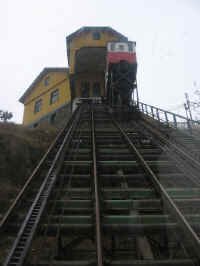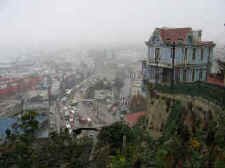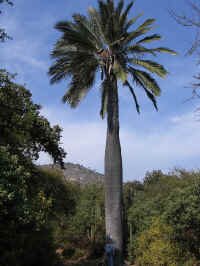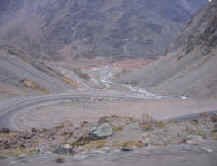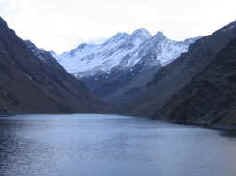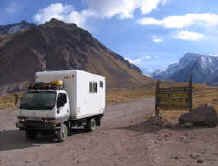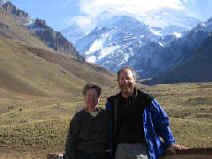|
May 1 - 5, 2006 - Chile Central Coast Across to Argentina We took a nice break at the beach in Pichilemu. Although the sun hid in the clouds most of the time, we were treated to shows by the surfers who come to this beach for the huge waves that break at the point where we were able to set up camp. The sound of the surf is a big change from the sounds of the quiet in the mountains, although it is always a good sound. Our day "off" was actually spent taking care of small repairs, cleaning and maintenance that we had been putting off. When we resumed our travel north, we continued to drive on the small back roads. We stopped to explore the area around the home of Chile's Poet Laureate and Nobel Prize recipient, Pablo Neruda. The home is in a beautiful coastal area on a cliff overlooking the beach. We then continued a few miles north to the town of El Quisco where we found a great camp spot next to the ocean with the surf crashing on the rocks just a few feet from us. In the morning we took a walk along the coast and marveled at the number of rental homes lining the road that were all closed up for the season. Every house fronting the ocean was closed! Today we drove through lots of fog and mist to finally reach the city of Valparaiso. Chile's second-largest city rises up from the coast and spreads onto the cliffs and hills surrounding it. Because of this, in the late 19th and early 20th centuries, funiculars called "ascensores" were built to provide easy access to the residential neighborhoods. Once numbering 33, there are now approximately 14 working funiculars. We rode three of them: Ascensor Artilleria which rises 175 meters with a 30 degree gradient, Ascensor Concepcion which climbs 69 meters with a gradient of 45 degrees and Ascensor Baron which rises 98 meters at a gradient of 60 degrees! All of the ascensores provide creaking rides that felt like they were going straight up and they all provided magnificent views at the top. We wandered around each of the neighborhoods and enjoyed the unique architecture clinging to the hillsides. Luckily, as the day wore on the fog lifted so that we could see the tops of the hills surrounding the city. After leaving the city, we continued north along the coast, admiring the views of the rocky shoreline while passing through the big tourist area of Vina del Mar. At one point the road detoured (we don't know why) and we were directed to drive right through a military base! It was very strange as usually the military is very private and even taking a photo can create problems. The next morning we decided to head inland to escape the persistently foggy and cloudy weather we had been encountering. We headed east and stopped at Parque Nacional La Campana. This World Heritage Site has the largest concentration of the rare Chilean Palm left in the country. These palms can grow to 25 meters in height and 1.5 meters in diameter. They don't flower until they hit sixty years old and can live to be 1,000! The trees have declined since the 19th century since they were exploited for their sap which was made into treacle. Some palms were so large that they reputedly produced up to 90 gallons of sap. Since we arrived around lunch time, we packed a picnic and took a hike to a mirador for a beautiful view and then found a fabulous spot next to a small rushing stream to eat our lunch. The sun was out and the temperature was the warmest it has been since we returned to South America. We then continued on to the San Felipe area to visit another winery. The town is the commercial center of a valley that exports wine and grapes due to its favorable microclimate. We chose to visit Vina Sanchez de Loria. The owner, a third generation winemaker, greeted us and proceed to take us through his bodega. While we watched, farm hands poured boxes of Sauvignon Blanc grapes into a crusher that was being powered by giant belts. We then proceeded to the 1890-era warehouse where we could see the grapes flowing through a hose into the wooden cask where they would sit for two days before being transferred to wooden barrels for fermenting. The process was classic and was the same way wine has been being made for hundreds of years. We enjoyed a tasting and walked away with a very satisfying experience. We then decided to head on toward the border with Argentina. The elevation at the pass is 3,863 meters which is 12,671 ft! In order to reach the pass, the road switchbacks up the mountain with at least 24 hairpin curves (we lost count after 24). It was also a very stark landscape, but nonetheless impressive. As it was getting dark, we decided to spend the night in the parking lot at Hotel Portillo which sits on beautiful Laguna del Inca at the elevation of 2,590 meters (8,495 ft). This drive is even more impressive as it follows the tracks of the railway that was completed in 1910. Our guidebooks describes this line as a marvel to engineering. As we drove we lost count of the number of tunnels cut through the rocky sides of the canyon and the number of bridges over the river. When the builders crossed rubble strewn alluvial deposits or old landslides, they either tunneled under the loose rock, or build free standing "tunnels" to deflect both rock and snow from the tracks. (We also got to drive through some of these tunnels on the car road.) We could understand why this line was constantly being worked on as we saw areas where the track had been wiped away by landslides, sometimes leaving the tracks hanging over washed out canyons. Right, the train no longer runs. After a very quiet night, we continued up the mountain. We checked out of Chile and entered the 3km long Tunel Cristo Redentor which passes through the mountain and under the border with Argentina. This was a first for us, we have never actually passed under a border before. When you emerge on the other side you are in Argentina. Before we reached the official immigration point, we came to the turnoff for the tallest mountain in the western hemisphere, Cerro Aconcagua at 6,962 meters (22,835 ft). The park was only a couple of kilometers off the road and the incredible view was only a couple of more kilometers hike. An awfully easy way to experience a fabulous mountain. The rest of the drive was very beautiful with gorgeous Andean scenery and running water. We spent the night in the midst of the Lujan wine country on the outskirts of Mendoza.
|
